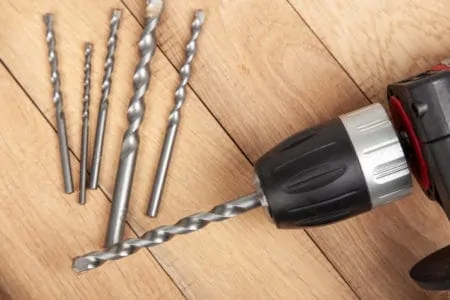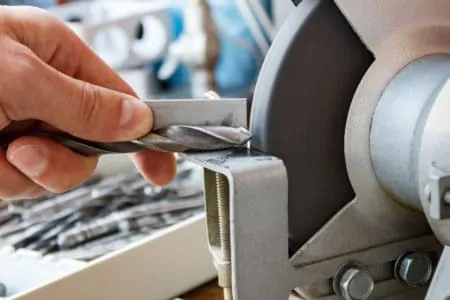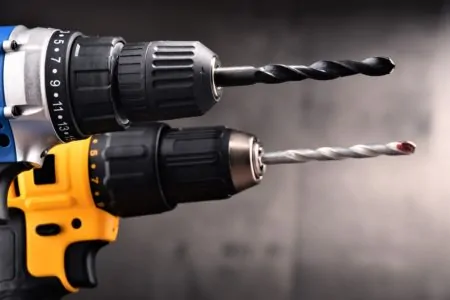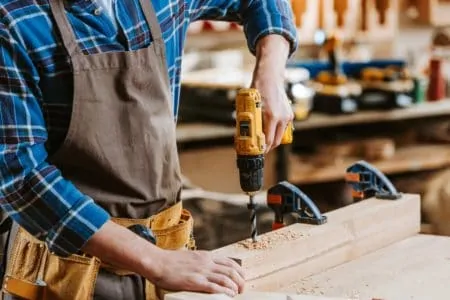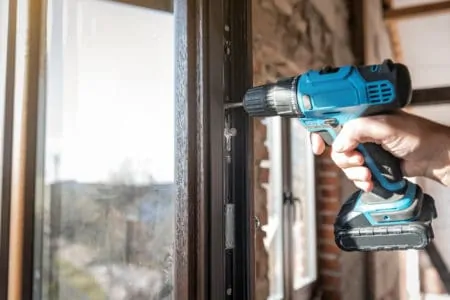Modern power drills enable us to make holes in various materials quickly and easily, transforming the way we work. However, there will be times when a standard drill won’t be powerful enough.
When you hit an obstruction and can’t seem to get past it, it might be time to turn to a hammer drill, which uses percussive force to enhance its power. If you haven’t used one before, you might be unsure how it works or why it will make a difference to your drilling.
In this article, we will explore a standard rotary drill vs. a hammer drill to see what sets each type apart. This includes how they work, how they differ, and which jobs they will be suitable for.
Key Takeaways
- Hammer drills are powerful and suitable for drilling into hard materials like concrete, stone, and brick.
- Rotary drills are versatile and ideal for drilling into softer materials like wood, metal, plastic, and tiles.
- Combination drills offer both rotary and hammer functions, making them a cost-effective choice for various tasks.
- Always use the appropriate drill bit and power setting for the material you are working with to ensure success.
Quick Comparison Chart
| Key Features | Drill | Hammer Drill |
| Weight | 5 to 7 pounds | 10 to 15 pounds |
| RPM/BPM | 1,000 to 1,500 RPM | 4,000 to 5,000 BPM |
| Suitable for | General-purpose drilling in softer materials | Making holes in harder materials |
| Cost | $ | $$ |
| Noise (dB) | 95 to 100 | 125 to 135 |
| Material | Wood, metal, plastic, tile | Concrete, stone, masonry |
| Size | Smaller and more compact | More cumbersome in size |
What is a Drill?
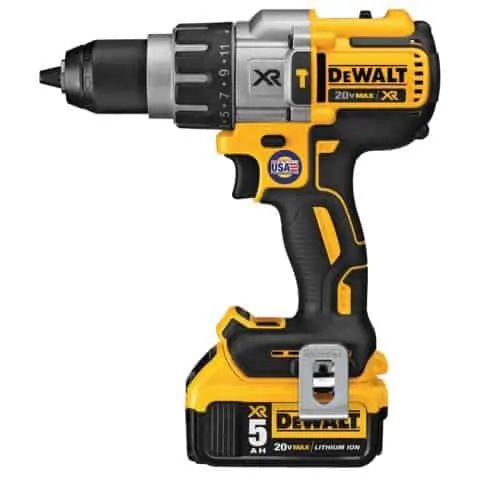
Drills have existed in some form for thousands of years but the modern handheld drill is also more than a century old. The drill takes its name from 17th-century middle Dutch — it derives from “drillen”, which means to bore or turn in a circle (1).
Drills are tools that are used to bore round holes in almost any material with the right motor and accessories. You can achieve this by either using a drill bit or a driver, secured by a chuck, with the type of bit determined by the material you are drilling.
Drills vary greatly in size, power, and speed, and some drills have a built-in hammer setting for more robust materials. These are called combination drills. There are also various types of handheld electric drills, including corded and cordless hammer drills.
What Do You Use a Drill For?
As their name suggests, drills are primarily used to make round holes in materials, typically wood. With the right drill bit and a powerful motor, it might also be possible to drill through plastic, composite, melamine, tiles, metal, and MDF. Drills are versatile tools that will help with any construction project and quick jobs such as mounting items on plasterboard or wooden walls.
Extra attachments can make drills even more versatile. It is possible to convert your drill into a knife sharpener, an electric polisher, a screwdriver, or a metal grinder.
If you are working with wood, a drill will speed up your tasks and help you achieve a neat, precise finish. It will even bore countersink holes and can mix paint, plaster, and grout for tiling.
Pros
- Powerful
- Ideal for fitting wall anchors
- Makes neat holes
- Speeds up many tasks
- Precise
Cons
- Noisy
- Messy
- Expensive
What is a Hammer Drill?
Hammer drills largely do what you probably expect of them, combining a hammering motion with a rotary movement for more effective drilling. The bit moves in and out with force, striking the material while also turning like a standard drill.
These combined movements help hammer drills penetrate tougher materials and this is the reason that they are sometimes called percussion drills. Percussion means striking one object with another using force. Hammer drills are loud, powerful tools.
What Do You Use a Hammer Drill For?
A hammer drill is used as an impact driver, drilling through dense, hard materials such as rock, concrete, stone, and brick. If you find yourself unable to make a hole with a standard rotary drill, a hammer drill might be able to do it for you.
Many modern drills offer rotary and hammer settings, or both at the same time. This means you will have the best of both worlds, using a standard drill but with the ability to hammer through any hard obstacles you encounter.
Pros
- Powerful
- Breaks through hard materials
- Impactful
- Versatile
Cons
- Noisy
- Vibrates
- Hard to use it accurately
- Messy
Drill vs. Hammer Drill
As a general rule, rotary drills are more suitable for drilling into softer or more delicate materials such as wood and tiles. Hammer drills are essentially the opposite, breaking through hard surfaces such as rock, stone, and masonry but with less precision.
However, there are some other differences. Rotary drills have a less pronounced chuck as there is no hammer action to take up extra space. They tend to be smaller and lighter than hammer drills. This makes them a better choice for working in tight spaces. As they have fewer components, they are also usually cheaper.
Hammer drills are heavier and their movement requires a larger chuck, which means they are generally longer than standard drills. They are heavier and more difficult to handle. They also make far more noise and are more expensive.
Finally, the combi drill is an amalgamation of the hammer drill and the standard rotary drill. Many drills sold in home improvement stores are combi drills as their versatility makes them ideal for the DIY community. A good combi drill will be able to complete the vast majority of drilling tasks in your home.
Combination Drills
Can You Use a Hammer Drill as a Regular Drill?
Hammer drills are unsuitable for standard drilling tasks due to their aggressive action. Using one to hang up a picture frame would be akin to swinging a sledgehammer at a walnut. Standard rotary drills have many uses because they are gentler and can also be used to drive screws, making them great general-purpose tools.
Hammer drills are best suited to hard materials such as stone, rock, and concrete. If you have a combination drill, you can switch between hammer and rotary modes to suit each material. Just remember not to use a hammer action on soft materials such as wood or you could damage them.
FAQs
Hammer It Out
Hammer drills and rotary drills have the same goal, making holes, but they function very differently. The percussive movement of hammer drills makes them the go-to tool when you need brute force to drill through hard materials. Standard rotary drills are versatile tools for everyday DIY and woodworking tasks and can perform various other roles with the right attachments.
If you want the best of both worlds, consider buying a combination drill. These tools can complete most of the tasks that hammer and rotary drills can, so you can save money by buying a combi drill instead of two more specialized drills.






